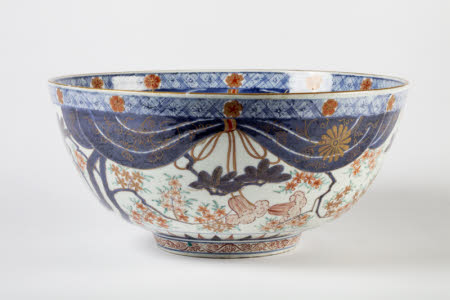Punch bowl
Category
Ceramics
Date
1695 - 1720
Materials
Porcelain, underglaze cobalt blue, overglaze polychrome enamels, gilt
Measurements
220 mm (Height); 460 mm (Diameter)
Place of origin
Arita
Order this imageCollection
Osterley Park and House, London
NT 771304
Summary
Punch bowls, a pair, porcelain, decorated in Imari type style and painted under the glaze in cobalt blue with over the glaze enamels in iron-red, green and yellow and gilt, with a design of billowing patterned window-blinds tied back with a tasselled cord, which reveal autumnal branches of maple leaves and pine branches, the rim with a diaper lattice band interspersed with flower heads and the interior base with a band of demi-chrysanthemum flowers, the foot with a band of foliate scrollwork in iron-red; Japan, Hizen province, Arita kilns, c. 1695-1720.
Full description
These large punch bowls have probably been together since they were made in the kilns in Arita, in Hizen province, on the Island of Kyushu, in Japan, around 1695-1720. They are decorated in the Imari type style with a limited palette of underglaze blue and overglaze enamels. The decoration is very bold and the designs adapted from those produced for local customers. The shape was probably made for export to the West, but such large bowls had many practical uses in any culture. The decoration depicts the window-blinds (sudare) made from slats of wood or bamboo with silk trim and tasseled cords, raised to view the scene of autumnal leaves. Such blinds were hung in temples, shrines and the homes of the nobility, often creating a barrier between the secular and spiritual worlds, offering privacy or relief from the summer heat. They featured prominently in the Tale of Genji, a novel written by lady-in-waiting Murasaki Shikibu (ca. 973–1014), recounting the life, tumultuous loves, and caddish behavior of Prince Genji. More specifically, the scene may recall chapter seven, 'Momiji no Ga' ('An Imperial Celebration of Autumn Foliages'). When these punch bowls were made, the Japanese export porcelain industry was competing with the much larger mass-produced Chinese industry. The Chinese were even able to produce very convincing copies of Japanese porcelain, and orders for Japanese porcelain for the West gradually ceased in the early 18th century. However, wares were still manufactured for the home markets in Japan. Patricia Ferguson, 2019
Provenance
Jersey Bequest, March 1993
Marks and inscriptions
Marked 386-1949


